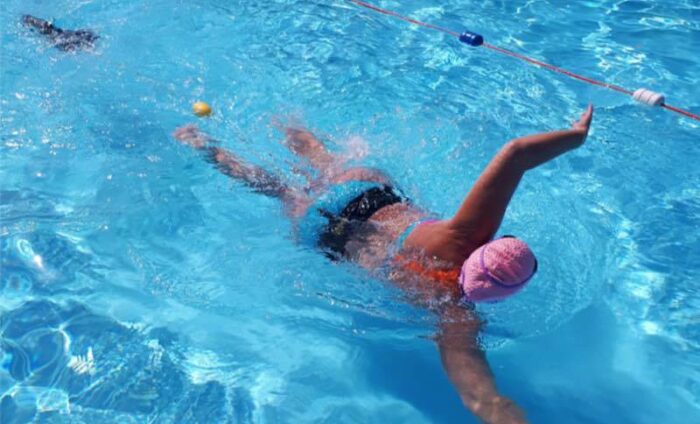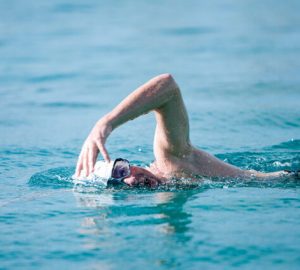
Last hurrah – session 4
A training session to keep you mentally and physically fresh for a great end of season performance. By Fiona Ford
Just because the racing season is coming to an end doesn’t mean you need to slow down. It’s just a case of doing the right training to keep you firing on all cylinders while holding fatigue at bay. The sessions in this issue are therefore aimed at extending your summer performances into a winter training block. If you’ve been focused on endurance training and distance freestyle events through the spring and summer, it can leave your technique in need of a refresh and your system in need of a gear change. To achieve this, and to keep you mentally and physically fresh at the end of a long season, there is nothing quite like using some new (or even old) equipment or training aids. These sessions help you incorporate any swim training gear you have already and suggest some recommended items, to put your training through its paces and add some variety. Your motivation and performance for any late season events should therefore move up a notch or two as a result!
There are four sessions to try. Aim to do one per week alongside your other training. Choose the number of repeats in the main sets to suit your current training aims and fitness level.
GEAR UP
You will need the following to train with through this series of sessions:
Pull buoy. Helps maintain a high hip and leg position. Use a very light flutter kick if you swim with the pull buoy between your thighs or no kick at all if you have the pull buoy between your knees or ankles. The latter works your deeper core muscles to rotate along your long axis, as you swim.
Long, flexible training fins, or try floating fins if you experience drag from a low leg position when swimming. I prefer the long fins as they help you develop proper kicking technique from the hips with a straighter leg whereas short fins allow swimmers to kick using their quads or a bent knee. Excessive knee bending compounds drag behind the body, particularly if you also do land based sports (particularly cycling and running) as you may have developed leg muscle movement dominance.
Technique paddles for improving catch and pull mechanics. Ideally use paddles that have few or no straps. You will gain much more feedback about how you push water behind you using smaller shaped paddles on these sessions. We are aiming to use the lats and back for propulsion, due to these being large muscle groups as this helps avoid shoulder injury.
Ankle band. Buy one or make your own using 30-40cm of old bicycle inner tube. Wearing an ankle band when swimming will help you identify any pause and glide at the front of your stroke caused by a lack of rhythm or slow cadence as you swim. If you have sinky legs from tight hip flexors or a weak core, this will also become obvious when you use an ankle band!
Front facing snorkel. Allows you to focus on technique and consistent breathing as you swim.
Surf or swim drag shorts. Wearing swim drag shorts increases the effort with which you need to swim efficiently and for many swimmers helps to highlight the extent of drag in their stroke and whether modifying their kicking technique (ie, straighter leg and kicking from hip) can help.
SESSION 4
Warm up (800m, all session)
200m FS, 400m with fins alternating FS and BS each length, 200m FS
Main set
8 – 10 x 200m with 30-60 sec rest after each as follows:
200m FS @ CSS/ threshold pace 200m FS with fins and snorkel, negative split effort (i.e. latter 100m to be faster than first). Maintain excellent technique and consistent exhalation throughout.
200m pull with paddles. Focus on propulsion during catch and pull.
200m paddles only. Finish stroke to thighs and consolidate rotation with bilateral breathing. 200m pull with ankle band. Maintain legs high in the water with core switched on. Exhale throughout. Remove pull buoy for greater challenge!
200m with drag shorts. Maintain good technique and stroke rate rhythm to overcome the additional drag from legs and hips.
200m FS @ CSS/ threshold pace. 200m with fins alternating BS and FS each length to check leg kick efficiency. Maintain good streamline with legs straight as you switch from front to back. *200m fins and paddles, aerobic pace. Snorkel optional. Consolidate technique elements.
*200m FS alternating fast and easy swimming each length. No gear.
* Last two are optional
Total
1600-2000m
Cool down (400m each session)
100m FS, 100m BRS, 100m BS, 100m FS
Total
2800-3200m
To keep you mentally and physically fresh at the end of a long season, there is nothing quite like using some new equipment or training aids
DEFINITIONS
100m FS, 100m BRS, 100m BS, 100m FS
BRS = Breast Stroke
BS = Back Stroke
Swim Smooth Squad training and Video Analysis sessions
Triathlon Europe provides weekly Swim Smooth squad training in South West London. The squad enjoy training all year round in fabulous indoor and outdoor 33m pools. Fiona offers swim training plans, 1-2-1 video analysis sessions and stroke correction sessions on weekday mornings and weekend Swim Smooth workshops.
Find out more: triathloneurope.com







